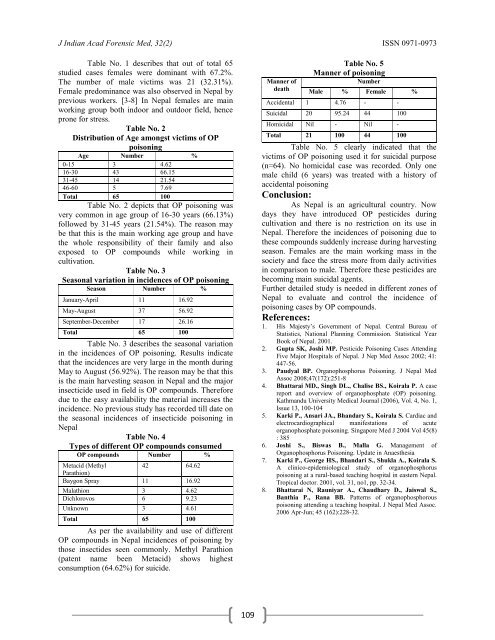jiafm, 2010-32(2) april-june. - forensic medicine
jiafm, 2010-32(2) april-june. - forensic medicine
jiafm, 2010-32(2) april-june. - forensic medicine
- No tags were found...
Create successful ePaper yourself
Turn your PDF publications into a flip-book with our unique Google optimized e-Paper software.
J Indian Acad Forensic Med, <strong>32</strong>(2) ISSN 0971-0973Table No. 1 describes that out of total 65studied cases females were dominant with 67.2%.The number of male victims was 21 (<strong>32</strong>.31%).Female predominance was also observed in Nepal byprevious workers. [3-8] In Nepal females are mainworking group both indoor and outdoor field, henceprone for stress.Table No. 2Distribution of Age amongst victims of OPpoisoningAge Number %0-15 3 4.6216-30 43 66.1531-45 14 21.5446-60 5 7.69Total 65 100Table No. 2 depicts that OP poisoning wasvery common in age group of 16-30 years (66.13%)followed by 31-45 years (21.54%). The reason maybe that this is the main working age group and havethe whole responsibility of their family and alsoexposed to OP compounds while working incultivation.Table No. 3Seasonal variation in incidences of OP poisoningSeason Number %January-April 11 16.92May-August 37 56.92September-December 17 26.16Total 65 100Table No. 3 describes the seasonal variationin the incidences of OP poisoning. Results indicatethat the incidences are very large in the month duringMay to August (56.92%). The reason may be that thisis the main harvesting season in Nepal and the majorinsecticide used in field is OP compounds. Thereforedue to the easy availability the material increases theincidence. No previous study has recorded till date onthe seasonal incidences of insecticide poisoning inNepalTable No. 4Types of different OP compounds consumedOP compounds Number %Metacid (Methyl42 64.62Parathion)Baygon Spray 11 16.92Malathion 3 4.62Dichlorovos 6 9.23Unknown 3 4.61Total 65 100As per the availability and use of differentOP compounds in Nepal incidences of poisoning bythose insectides seen commonly. Methyl Parathion(patent name been Metacid) shows highestconsumption (64.62%) for suicide.Manner ofdeathTable No. 5Manner of poisoningNumberMale % Female %Accidental 1 4.76 - -Suicidal 20 95.24 44 100Homicidal Nil - Nil -Total 21 100 44 100Table No. 5 clearly indicated that thevictims of OP poisoning used it for suicidal purpose(n=64). No homicidal case was recorded. Only onemale child (6 years) was treated with a history ofaccidental poisoningConclusion:As Nepal is an agricultural country. Nowdays they have introduced OP pesticides duringcultivation and there is no restriction on its use inNepal. Therefore the incidences of poisoning due tothese compounds suddenly increase during harvestingseason. Females are the main working mass in thesociety and face the stress more from daily activitiesin comparison to male. Therefore these pesticides arebecoming main suicidal agents.Further detailed study is needed in different zones ofNepal to evaluate and control the incidence ofpoisoning cases by OP compounds.References:1. His Majesty‟s Government of Nepal. Central Bureau ofStatistics, National Planning Commission. Statistical YearBook of Nepal. 2001.2. Gupta SK, Joshi MP. Pesticide Poisoning Cases AttendingFive Major Hospitals of Nepal. J Nep Med Assoc 2002; 41:447-56.3. Paudyal BP. Organophosphorus Poisoning. J Nepal MedAssoc 2008;47(172):251-84. Bhattarai MD., Singh DL., Chalise BS., Koirala P. A casereport and overview of organophosphate (OP) poisoning.Kathmandu University Medical Journal (2006), Vol. 4, No. 1,Issue 13, 100-1045. Karki P., Ansari JA., Bhandary S., Koirala S. Cardiac andelectrocardiographical manifestations of acuteorganophosphate poisoning. Singapore Med J 2004 Vol 45(8): 3856. Joshi S., Biswas B., Malla G. Management ofOrganophosphorus Poisoning. Update in Anaesthesia7. Karki P., George HS., Bhandari S., Shukla A., Koirala S.A clinico-epidemiological study of organophosphoruspoisoning at a rural-based teaching hospital in eastern Nepal.Tropical doctor. 2001, vol. 31, no1, pp. <strong>32</strong>-34.8. Bhattarai N, Rauniyar A., Chaudhary D., Jaiswal S.,Banthia P., Rana BB. Patterns of organophosphorouspoisoning attending a teaching hospital. J Nepal Med Assoc.2006 Apr-Jun; 45 (162):228-<strong>32</strong>.109



![syllabus in forensic medicine for m.b.b.s. students in india [pdf]](https://img.yumpu.com/48405011/1/190x245/syllabus-in-forensic-medicine-for-mbbs-students-in-india-pdf.jpg?quality=85)



![SPOTTING IN FORENSIC MEDICINE [pdf]](https://img.yumpu.com/45856557/1/190x245/spotting-in-forensic-medicine-pdf.jpg?quality=85)

![JAFM-33-2, April-June, 2011 [PDF] - forensic medicine](https://img.yumpu.com/43461356/1/190x245/jafm-33-2-april-june-2011-pdf-forensic-medicine.jpg?quality=85)



![JIAFM-33-4, October-December, 2011 [PDF] - forensic medicine](https://img.yumpu.com/31013278/1/190x245/jiafm-33-4-october-december-2011-pdf-forensic-medicine.jpg?quality=85)


